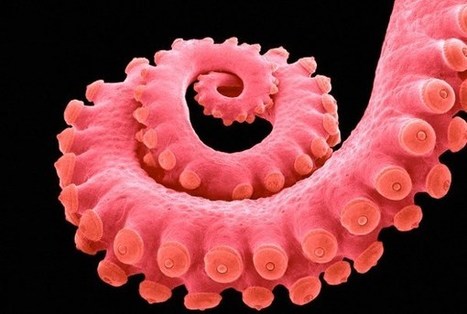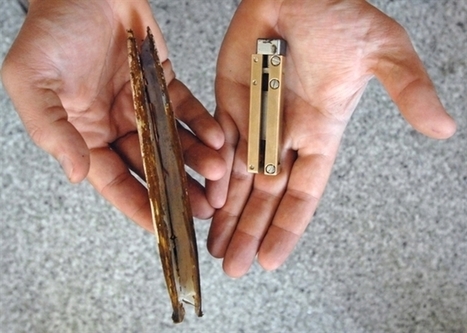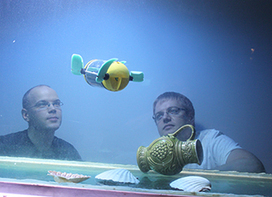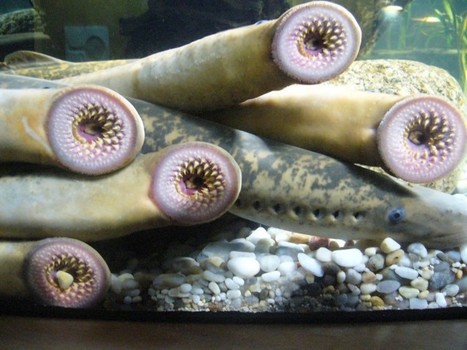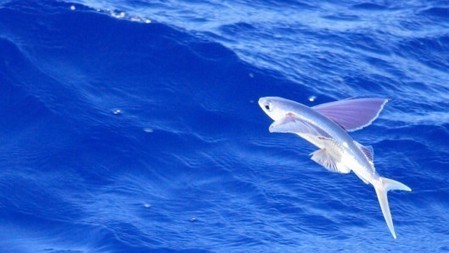 Your new post is loading...
 Your new post is loading...
A team of researchers from China and the U.S. has created a robot that is able to mimic a remora fish by adhering quickly and strongly to underwater objects.
The mudskipper is a fascinating animal, in that it's a fish that both swims in the water and crawls on the land. It's probably not unlike the prehistoric fishes that first ventured out of the ocean, hundreds of millions of years ago. Looking at it, you might think that its two pectoral fins do all the work when it's out of the water, while its tail just flaps around. By building a robotic version of the mudskipper, however, scientists have learned that its tail plays a crucial role while it's on the land – the finding could have implications for the design of walking robots.
"NASA has chosen its next batch of proposals under its advanced concepts program, including the use of soft-robotic rovers for exploring gas-giant moons, and autonomous robots capable of crawling, hopping, and rolling around the surface of the Moon. [...] One of the more interesting proposals calls for a soft robotic squid/eel hybrid. The device would be equipped with a short antenna on its back to draw power from changing magnetic fields. The aquatic rover could be used to explore the subsurface oceans on Europa and Enceladus."
"Surgeries might be easier and safer due to a new invention by researchers from the Sant'Anna School of Advanced Studies in Italy, a robotic arm that was inspired by tentacles of an octopus. The robotic arm device moves by using its inflatable chambers, imitating the natural motion of an octopus twisting and elongating its tentacles in any direction it desires."
Studying the movements of creatures in the natural world is very useful to robotics as the latest version of a robotic octopus from Greece shows. But real octopodes could also learn from their robotic cousin, which uses its octopus-inspired anatomy to propel itself in new ways.
"At MIT, nature has long been a source of inspiration, and in a new project two researchers turn to the razor clam as inspiration for their burrowing robot. The burrowing bot, know as the RoboClam, is about half the size of a lighter but is controlled by an off board set of apparatuses, including pressure regulators, pistons and other control mechanisms."
"The Robot Safari in London Science Museum will see the world premiere of the underwater robot U-CAT, a highly maneuverable robot turtle, designed to penetrate shipwrecks. U-CAT’s locomotion principle is similar to sea turtles. Independently driven four flippers make the robot highly maneuverable; it can swim forward and backward, up and down and turn on spot in all directions. Maneuverability is a desirable feature when inspecting confined spaces such as shipwrecks. The robot carries an onboard camera and the video footage can be later used to reconstruct the underwater site."
"The Japanese spider crab is about to lose its title as the world's largest crustacean thanks to a new robot, the Crabster, developed in South Korea. For the past 2 years, researchers at the Korean Institute of Ocean Science and Technology (KIOST) have been working on a giant robot crab that is about the size and weight of a Smart car. This summer it will help scientists explore wrecks below the sea, weathering harsh tidal currents rushing over it at 1.5 m/s."
Engineers from Virginia Tech have created Cryo, a 170lb robotic jellyfish that could be used for Navy spy missions.
Speedy tuna capable of swimming tirelessly in the Earth's oceans have inspired the U.S. Department of Homeland Security to fund a lookalike robot for underwater patrols. The "BIOSwimmer" robot features faithfully replicated fins and a flexible tail to pull off quick maneuvers like the real-life fish.Homeland Security made the choice to fund the robot made by the Boston Engineering Corporation in Waltham, Mass., with an eye toward missions such as exploring the flooded areas of ships, inspecting oil tankers or patrolling U.S. harbors to watch out for suspicious activity.
Nissan's EPORO robot car prototypes are programmed to think and act like a school of fish to avoid collision.
A tiny “living,” swimming robot that could be used to detect diseases in the human body is being developed by U.K. and U.S. researchers.
|
"Using a mathematical model and the mackerel pectoral fin as an illustrative example, [...] researchers show how fin stiffness may be changed by applying a u-shaped curvature at the fin's base. The effect, the researchers say, might underlie the ability of fish to swim at widely varying speeds in all kinds of currents with great maneuverability. [...] The researchers say their model suggests intriguing possibilities for the design of robotic swimmers."
It’s hip to be square if you’re a seahorse—or rather, it has certain adaptive advantages. Cylindrical tails may be much more popular in the animal kingdom, but the seahorse’s bizarre square-prism tail has far better mechanical properties.
The European Union CoCoRo research consortium has been developing three varieties of autonomous underwater robots that school together like fish. By doing so, the little bots can share and learn from each others' "knowledge" of their environment, acting as a collective cognitive system.
"When you inflate a balloon and then release it without tying the valve shut, it certainly shoots away quickly. Octopi utilize the same basic principle, although they suck in and then rapidly expel water. An international team of scientists have now replicated that system in a soft-bodied miniature underwater vehicle, which could pave the way for very quickly-accelerating full-size submersibles."
"Octopi are pro swimmers, thanks (at least in part) to that octet of arms they've got going on. They've adopted a particular swimming gait called sculling, which works great for them, but until they start publishing scientific papers, we're missing out on all of their gait testing data. Roboticists have had to start from scratch, and along the way, they've experimented with some swimming gaits that we've never seen a real octopus try and pull off."
"A number of robotic fish are going to be used in an experiment in the port of Gijon in Spain in order to evaluate how effectively and cost-efficiently they can detect water pollution. The carp-shaped robots are part of a three-year research project of Huosheng Hu and his robotics team at the School of Computer Science and Electronic Engineering, University of Essex. The robot fish could be used to inspect rivers, lakes and seas. The life-like creatures, which mimic the undulating movement of real fish, are 1.5 meters (5 feet) long and will be equipped with tiny chemical sensors. These sensors are used to find sources of potentially hazardous pollutants in the water, such as leaks from vessels in the port or underwater pipelines. When they recharge their batteries via a “charging hub” they will be able to transmit the information to the port’s control center. This will enable the authorities to map the source and scale of the pollution virtually in real time."
"A quirk of nature has long baffled biologists: Why do animals push in directions that don't point toward their goal, like the side-to-side sashaying of a running lizard or cockroach? An engineer building a robot would likely avoid these movements because they seem wasteful. So why do animals behave this way?
A multi-institutional research team, led by Johns Hopkins engineers, says it has solved this puzzle. In an article published in the Nov. 4-8 online edition of Proceedings of the National Academy of Sciences, the team reported that these extra forces are not wasteful after all: They allow animals to increase both stability and maneuverability, a feat that is often described as impossible in engineering textbooks."
"Researchers at Stanford University have developed a small aircraft that resembles a flying fish which can jump and glide over a greater distance than an equivalent jumping robot. Using a carbon fiber spring to take off, the jumpglider has a pivoting wing that stays out of the way during ascent, but which locks into place to glide farther on the way down."
Mankind's attempts to create robotic humans that move exactly like us have so far been far from perfect. They usually stumble around, desperately trying to keep their balance like a toddler taking its first steps.
A mola, or ocean sunfish, is a very big, very flat, and (in this reporter's opinion) rather silly looking tropical bony fish. Aerovioronment has used the sunfish as an inspiration for one of their latest proof of concept robots: Mola, an oceangoing robot that's powered by the sun.
A new robotic jellyfish is powered by hydrogen, and could theoretically never run out of energy as it pulses through the sea. It’s designed to work as a search and rescue or surveillance ‘bot for the U.S. Navy.
|
 Your new post is loading...
Your new post is loading...
 Your new post is loading...
Your new post is loading...









